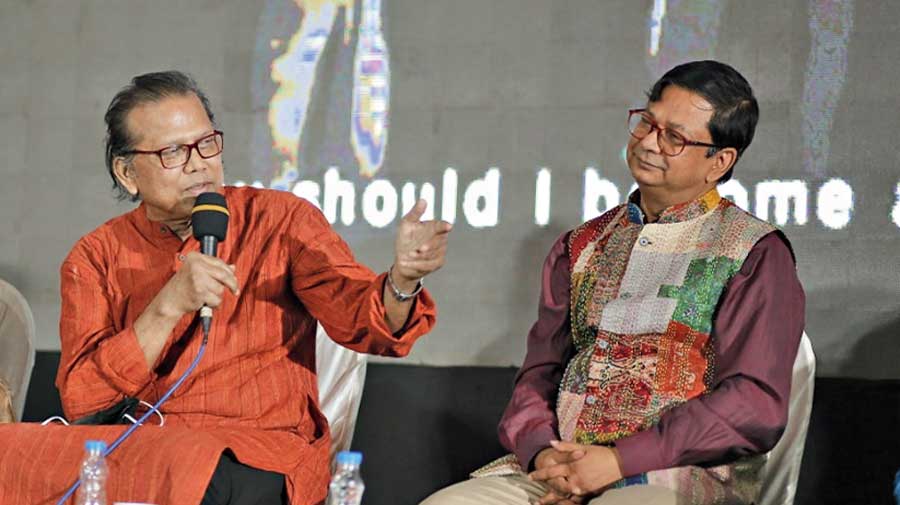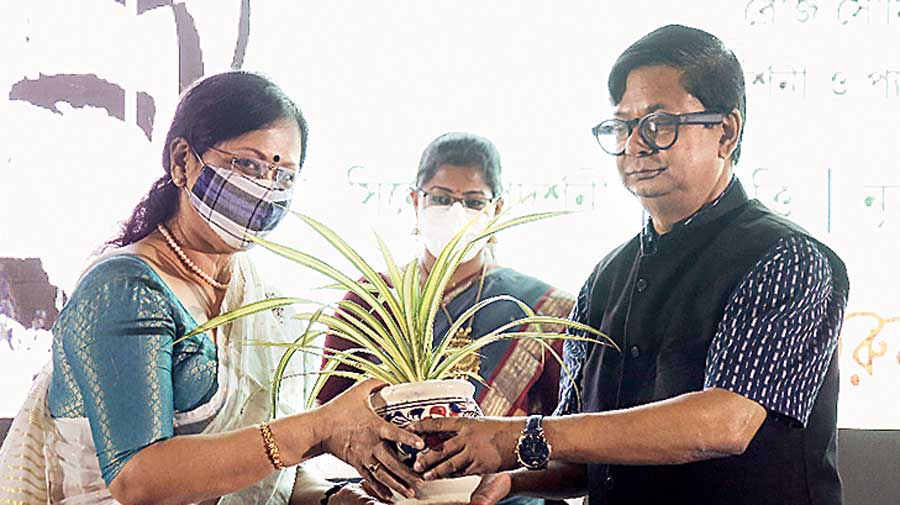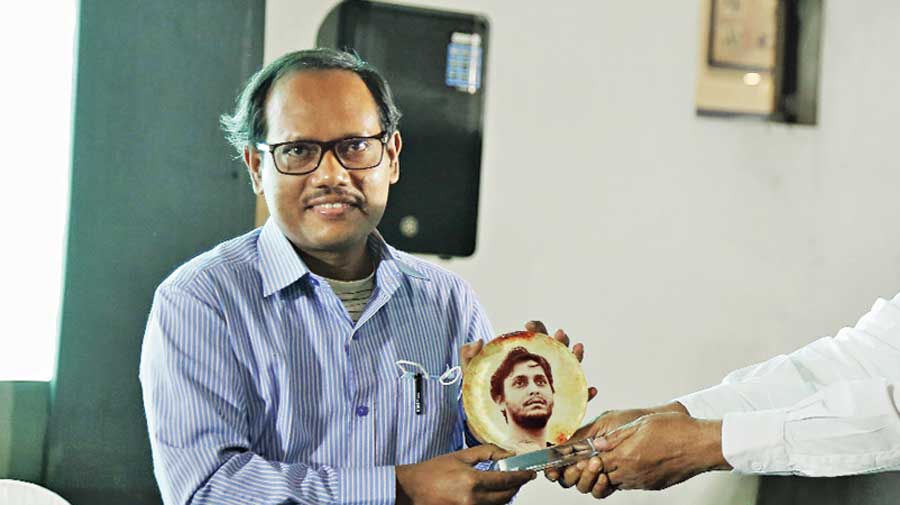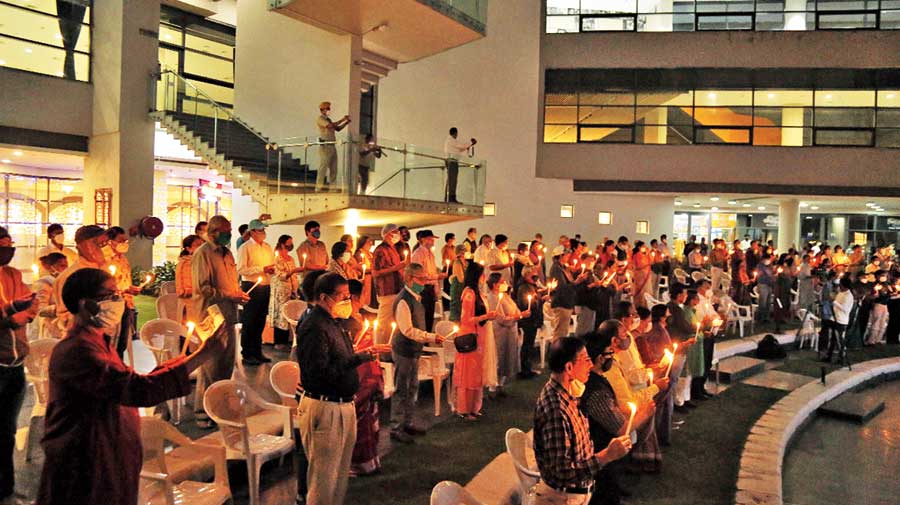Had they given us bok phool and kumro phool in place of these flowers, they could be fried and eaten.” These words, spoken in an undertone, came from Soumitra Chatterjee during a felicitation with bouquets of flowers in course of the curtain call for the play Phera. “Such was his sense of humour,” smiled Debsankar Halder, who acted in the play with him.
Such intimate memories and impressions from his colleagues formed the core of the four-day homage at Nazrul Tirtha titled ‘Remembering Soumitra’, paid by the Housing and Infrastructure Development Corporation (Hidco), to the thespian who passed away on November 15.
Debsankar, who spoke on the inaugural day of the event, took Soumitra’s last on-camera interview over two hours along with fellow theatre personality Koushik Sen before he contracted Covid-19. “Even till the end, he was so full of life force! He told us he wanted a play to be conceived in today’s language which would shake up everything around yet whose epicentre could not be pinpointed. He wished he could be part of such a phenomenon in theatre. Imagine an 85-year-old having such zest!”
In Phera, Debsankar used to play a character that Soumitra himself used to play decades ago. “He had shifted to a smaller role. I used to wonder if he ever compared my acting to how he used to do it 30 years ago. But he never uttered a word that could hurt me. If I ever asked him for suggestions, he would smilingly point out that even to show something to be done the way he used to, he would have to travel back those many years. ‘Tomar boyeshe giye toh ami dekhate parbo na,’ he used to smilingly say. Rather, he used to support me on stage with so much fondness,” he recalled, delivering an exchange between the two from the play to demonstrate the understanding they shared as actors.
Of course, he would still be analytical. “If he praised any particular scene after a performance, I would realise that there was scope for improvement there.”
As part of the homage, four of Soumitra’s films were exhibited at Nazrul Tirtha — Apur Sansar, Joy Baba Felunath, Atanka and Paromitar Ek Din. “But you cannot show his plays. Yes, you can show recordings of the plays, but those would be documentations, not the real thing. Theatre is like good food. It is meant to be consumed and then it is over. He loved this ephemeral quality of theatre.”
Debsankar, who is known much more for his body of work on stage than in films, stressed on Soumitra’s commitment to commercial theatre. “He would take leave even from Satyajit Ray every Thursday, Saturday and Sunday to go and act on stage. He had translated a German play by Friedrich Durrenmatt as Phera, in which till before the lockdown we acted together. His other productions too were awe-inspiring — Namjibon, Neelkantha, Rajkumar... He was very sensitive to the fact that the poor, who did not have access to more expensive forms of art, came to watch theatre, especially in venues like the Academy (of Fine Arts). Someone who, despite being at the height of stardom, found time for commercial theatre deserved more support. But he was not given his place by the theatre world which saw him more as a film hero.”
Asked to differentiate between acting in films and on stage, Soumitra had told him that the latter was like the situation of a lover, who is unsure if his love is requited, mustering courage over days and finally declaring his feelings. “That is the one shot you get. It’s out of your hands after that. Much like a rocket cracker. You set its fuse alight and off it goes defying gravity, leaving no trace. In films, you can keep polishing and changing and rejecting till you are satisfied. His response had given me goose bumps.”
During performances, Debsankar recalled seeing Soumitra sit in the wings, hidden from audience gaze, long before his own entry was due, instead of relaxing in the make-up room. “It was a play written by him, which once he had directed but now had passed on the reins. His character was yet to enter but mentally he was already there.”
Age could not wither him. “Once he was unwell, and I asked him if he would turn up for a performance the next day, he said if he did not, he might not bring himself to come even the day after. It was his pride as an actor to stand and deliver in front of the audience.”
His response was similar even when Debsankar silently held out his hand for support, seeing the 84-year-old about to climb down stairs. “He instinctively withdrew his hand, By way of explanation, he added: ‘Debu, if I take your hand today, I will need it tomorrow as well when you might not be there.’”
Pride was evident even in the process he adopted in his acting. For the play Bidehi, an adaptation he had done of the play Ghosts by Henrik Ibsen long back which he reworked recently, he would put in a wooden block as a platform under his shoe to portray a limp. “He had vertigo and the block made him dizzy. So he would take it off between scenes. I often wondered why he did that because a limp could be feigned. He used to smile and say ‘Besh lage’. Later I understood the block was what the floating log was to Bilbamangal, who was trying to cross the river to reach his beloved Chintamani by clutching on to a floating log which actually was a carcass. If the beloved was Bilbamangal’s life, in Soumitra’s case it was acting. They tried to reach their destination by dint of their passion. Incidentally, he had acted in the Girish Ghosh play Bilbamangal himself.”
Soumitra, Debsankar felt, refused to be categorised. “If you did not like him as actor, he would present himself as elocutionist. If you did not like his poetry, he would ask you to look at his writings. If even those you considered below par, he would ask you to look at his theatre. If nothing worked, he would happily sit face to face with you and indulge in a conversation, and see if his words only floated about like bubbles before popping into thin air or some made their way into your mindspace and stayed there.”
Soumitra’s fondness for adda was brought up by several speakers. Debsankar mentioned how he would meet with friends at a common acquaintance’s place after lockdown was eased at an interval of every 20 days. “He spent the lockdown very actively. He wrote three plays and did some translations. He also used to compose two poems daily.”
A bonus for the audience at the open air auditorium was the actor breaking into some lines from Ajitesh Bandyopadhyay’s Soudagorer Nouka, on the lips of a rejected actor who imagines the courtyard of his house to be a theatre and delivers his lines in solitude. “Ajitesh was a favourite of his and he enjoyed listening to these lines from me. We used to celebrate his birthday with a programme every January 19. Once he had asked me to recite these lines for everyone present. Next year, too, we will celebrate the day with him just as we are doing so with him amidst us today,” Debsankar concluded.

Filmmaker Sekhar Das makes a point as Hidco chairman and moderator of the panel discussion Debashis Sen looks on at Nazrul Tirtha last Friday on the second day of the event Telegraph picture
The Uttam comparison
Filmmaker Sekhar Das, a resident of Moonbeam Housing in New Town, has made two films with Soumitra. He started with comparing the two pillars of the Bengali film industry — Uttam Kumar and Soumitra. “I had seen Uttam Kumar at a Bengal Film Journalists Association event where my girlfriend shrieked on spotting the angelic figure. He did not believe in mingling with people to protect his aura. By then, Soumitra had danced to Jibone ki pabona (Teen Bhuboner Pare, 1969). Yet one day, there he was walking into Coffee House in his pyjamas to join the likes of Sunil Ganguly. He did not believe in star worship,” Das said.
Years later, Das recalled seeing him walk out of the green room for a cup of tea at the streetside with alacrity before taking the stage for Naamjibon.
He touched upon some milestones in Soumitra’s career, mentioning how as a young actor, he acted shoulder to shoulder opposite Suchitra Sen, senior to him in years, in Saatpake Badha, sought director Tapan Sinha’s permission to change his 50-year-old appearance slightly to enact the 70-year-old teacher witnessing his student stabbing someone to death in Atonko, played a thief in Tarun Majumdar’s Sansar Simante or the priest Gangacharan in Satyajit Ray’s Asani Sanket. “He had started acting under the tutelage of doyens Sisir Bhaduri and Ahindra Chowdhury who were both great teachers.”
Of the time spent together on the sets of his film Krantikaal, he recalled being woken up at dawn — hours before the 10am call time - by a knock on the hotel door. “There he was greeting the bleary-eyed me. He said he was up all night rehearsing a song I had asked him to give lip to and then composed a poem which he wanted to read out to me.”

Sudeshna Roy on Day II of the event Telegraph picture
When Krantikaal got the National Award, he was invited to the film festival in Goa where they wanted to felicitate him. “But he said he had committed four dates to Swapan Saha (a maker of potboilers). He believed in commitments and never distinguished between big and small names.”
Satarupa Sanyal spoke of her unfulfilled desire of making a film with Soumitra. “I wanted to direct Shankar’s story Kakolir Dadu with him in the lead. I got the rights from the author, went over to Soumitrababu’s Golf Green house and gave him a script narration, he agreed to do the film and received the advance… But I failed to raise funds. The film never got made.”
She did shoot Soumitra later for two documentaries — one on Manna Dey and the other on Mohun Bagan — but the disappointment remained.

Filmmaker Satarupa Sanyal receives a sapling on Sunday Telegraph picture
Sudeshna Roy, the journalist turned actor and filmmaker, first saw Soumitra at a wedding in her childhood. “I had taken his autograph then.” Later, as a journalist with Sananda, she interviewed him many times. “My editor was Aparna Sen who had an easy rapport with Soumitra. We worked together for the first time for a telefilm in 2001. It was a Tagore short story for ETV Bangla and Gargee Roychowdhury was to play his daughter. Fifteen years later, when he did Sraboner Dhara, Gargee was playing his wife. When I mentioned the rest of the cast, he smiled and said: ‘Gargeer podonnoti hoyechhe — meye theke stree.’ Such was his memory!”

Visitors were asked to pen their tributes to Soumitra Chatterjee on a white board at the reception. Kaushik Pattanayak of East Enclave Housing Complex got a plaque for his poem which was adjudged the best Telegraph picture
She shared anecdotes heard from him over the years. “He never objected when I called him a Ray product. Rather he told us when Ritwik Ghatak had badmouthed Ray on stage at an event, he had lost his cool and confronted him. Such was his loyalty to his mentor.”
One role he had admitted wanting to do was Goopi Gyne. “He had asked Ray to give him the role. But Ray said he looked more like a prince than a village bumpkin. He told us that he went to the first show of Goopi Gyne Bagha Byne, hoping to have his I-told-you-so moment with Ray. ‘Kintu Tapen ta eto bhalo obhinoy korechhe je ami kichhu bolte parlam na,’ he confessed to us.

last bow: Candles lit in remembrance as the audience sings Aguner Poroshmoni in chorus Telegraph picture
Uttam Kumar, he said, used to object to his sauntering on the streets in his pyjamas, smoking. “But he said that he could not be Soumitra all his life. He needed to be on the streets to study characters and hone his acting skills.”
His wit shone through in his response to Roy’s query on the Uttam-Soumitra feud, much discussed in the press and in public debates. ‘He (Uttam) was a lot bigger than me,’ he said, adding mischievously after a pause, ‘in age’.”











